
Pentatomidae is a family of insects belonging to the order Hemiptera, generally called shield bugs or stink bugs. Pentatomidae is the largest family in the superfamily Pentatomoidea, and contains around 900 genera and over 4700 species. As hemipterans, the pentatomids have piercing sucking mouthparts, and most are phytophagous, including several species which are severe pests on agricultural crops. However, some species, particularly in the subfamily Asopinae, are predatory and may be considered beneficial.

Lepturinae, the lepturine beetles, is a subfamily of the longhorn beetle family (Cerambycidae), containing about 150 genera worldwide. This lineage is most diverse in the Northern Hemisphere. Until recently the subfamily Necydalinae was included within the lepturines, but this has been recently recognized as a separate subfamily. Nine tribes are usually recognized today, with a tenth, Caraphiini, created in 2016. A few genera are of uncertain placement within the subfamily.

Hydrochus is the only living genus of beetle in the family Hydrochidae, which belongs to the superfamily Hydrophiloidea, and was formerly treated as a subfamily of Hydrophilidae. Hydrochus includes about 180 species, which are found worldwide. The name "Hydrochus" has also been used for a fly genus in the family Dolichopodidae, but this is a junior subjective synonym of the genus Rhaphium.

Chrysomela is a genus of leaf beetles found almost throughout the world, but not in Australia. It contains around 40 species, including 7 in eastern and northern Europe. It also includes at least 17 species in North America, including the cottonwood leaf beetle Chrysomela scripta.
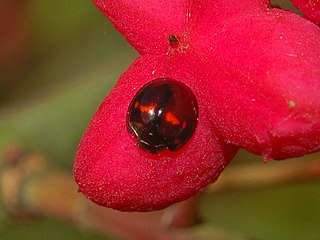
Chilocorus is a genus of beetles belonging to the family Coccinellidae, subfamily Chilocorinae.

Coccinellinae is a subfamily of lady beetles in the family Coccinellidae. There are at least 20 genera and 90 described species in Coccinellinae.

Psyllobora is a genus of fungus-eating lady beetles in the family Coccinellidae. There are about 17 described species in Psyllobora.
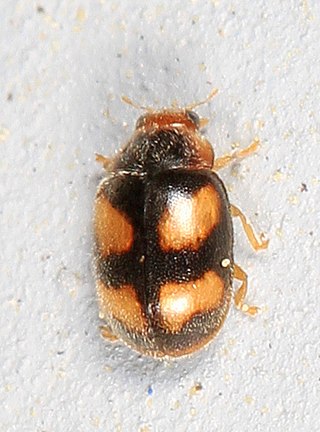
Diomus is a genus of lady beetles in the family Coccinellidae. There are at least 20 described species in Diomus.

Novius is a genus of ladybird beetles belonging to the family Coccinellidae, and the sole member of the tribe Noviini. The genus as presently defined contains over 70 species, most of which were formerly placed in the genera Rodolia and Anovia, but after decades of debate, both of these genera are now considered to be junior synonyms of Novius.

Pediobius foveolatus (Crawford), is a tiny exotic parasitoid wasp that is used for biological control of Mexican bean beetle, Epilachna varivestis, an important insect pest of snap beans, lima beans, and sometimes soybeans mainly found at economic levels in the eastern United States. Pediobius foveolatus is in the family Eulophidae, and is the most successful biological control agent for Mexican bean beetle. This wasp only attacks beetle larvae, not eggs or adults. It is commonly used by smaller, organic growers; but is also mass released throughout the state of New Jersey, by their state department of agriculture.

Henosepilachna is a genus of beetle in the family Coccinellidae, including several pest species, such as the 28-spotted potato ladybird.

Brachiacantha is a genus of lady beetles in the family Coccinellidae. There are at least 25 described species in Brachiacantha.
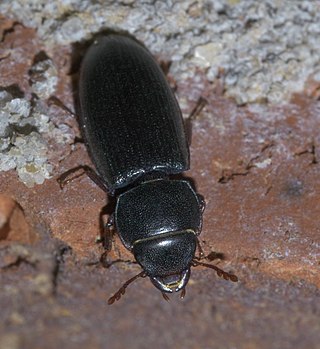
Tenebroides is a genus of bark-gnawing beetles in the family Trogossitidae. There are at least 20 described species in Tenebroides.
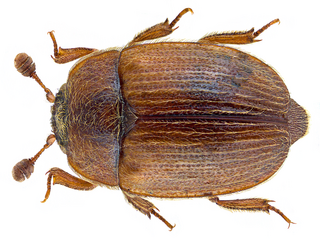
Pocadius is a genus of sap-feeding beetles in the family Nitidulidae. There are about nine described species in Pocadius.
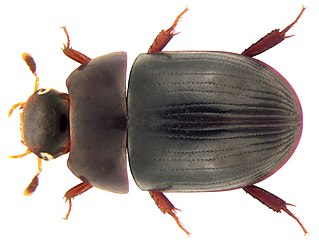
Dactylosternum is a genus of water scavenger beetles in the family Hydrophilidae. There are more than 20 described species in Dactylosternum.

Diekeana is a genus of beetle in the family Coccinellidae, formerly included within the genus Epilachna.
















